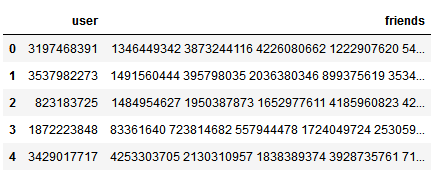Event Recommendation Engine Challenge分步解析第三步
一、请知晓
本文是基于:
Event Recommendation Engine Challenge分步解析第一步
Event Recommendation Engine Challenge分步解析第二步
需要读者先阅读前两篇文章解析
二、用户社交关系信息处理
这一步需要user_friends.csv.gz文件,我们先来看看文件内容:
import pandas as pd
df_user_friends = pd.read_csv('user_friends.csv.gz', compression='gzip')
df_user_friends.head()
代码示例结果(发现该记录了用户的所有朋友信息):

1)变量解释
nusers:train.csv和test.csv文件涉及的所有用户数目,3391
self.numFriends:一维向量,每个元素记录了(3391个)每个用户的朋友数目,然后除以总的朋友数(sumNumFriends),得到每个用户的朋友占比
import scipy.io as sio
import pandas as pd
numFriends = sio.mmread('UF_numFriends')
pd.DataFrame(numFriends)
代码示例结果:

self.userFriends:稀疏矩阵,shape为(3391,3391),记录每个用户与其朋友的score矩阵,最后归一化
import scipy.io as sio
import pandas as pd
userFriends = sio.mmread('UF_userFriends').todense()
pd.DataFrame(userFriends)
代码示例结果:


userEventScores:临时变量,记录某个用户的某个朋友对每个event的兴趣分(1,0,or -1)
sumNumFriends:每个用户的朋友数相加之和
2)记录对user_friends.csv.gz文件操作
逐行读取user_friends.csv.gz文件
如果用户在第一步中userIndex中,获取该用户的朋友数目,并保存在self.numFriends中
对于该用户每一个朋友,只操作存在于第一步中userIndex中的朋友
获得该朋友的Index,利用该index去操作第一步中的userEventScores,这个userEventScores记录了每个用户对每个event的兴趣分(1,0,or -1),这样我们就获得了该用户的该朋友对每个event的兴趣分,
并求得该用户的该朋友的平均兴趣分(对每个event的兴趣分和除以总得event数-13481)
3)有了上面对user_friends.csv.gz文件操作说明,我们来看看完整代码
from collections import defaultdict
import locale, pycountry
import scipy.sparse as ss
import scipy.io as sio
import itertools
#import cPickle
#From python3, cPickle has beed replaced by _pickle
import _pickle as cPickle import scipy.spatial.distance as ssd
import datetime
from sklearn.preprocessing import normalize import gzip
import numpy as np #处理user和event关联数据
class ProgramEntities:
"""
我们只关心train和test中出现的user和event,因此重点处理这部分关联数据,
经过统计:train和test中总共3391个users和13418个events
"""
def __init__(self):
#统计训练集中有多少独立的用户的events
uniqueUsers = set()#uniqueUsers保存总共多少个用户:3391个
uniqueEvents = set()#uniqueEvents保存总共多少个events:13418个
eventsForUser = defaultdict(set)#字典eventsForUser保存了每个user:所对应的event
usersForEvent = defaultdict(set)#字典usersForEvent保存了每个event:哪些user点击
for filename in ['train.csv', 'test.csv']:
f = open(filename)
f.readline()#跳过第一行
for line in f:
cols = line.strip().split(',')
uniqueUsers.add( cols[0] )
uniqueEvents.add( cols[1] )
eventsForUser[cols[0]].add( cols[1] )
usersForEvent[cols[1]].add( cols[0] )
f.close() self.userEventScores = ss.dok_matrix( ( len(uniqueUsers), len(uniqueEvents) ) )
self.userIndex = dict()
self.eventIndex = dict()
for i, u in enumerate(uniqueUsers):
self.userIndex[u] = i
for i, e in enumerate(uniqueEvents):
self.eventIndex[e] = i ftrain = open('train.csv')
ftrain.readline()
for line in ftrain:
cols = line.strip().split(',')
i = self.userIndex[ cols[0] ]
j = self.eventIndex[ cols[1] ]
self.userEventScores[i, j] = int( cols[4] ) - int( cols[5] )
ftrain.close()
sio.mmwrite('PE_userEventScores', self.userEventScores) #为了防止不必要的计算,我们找出来所有关联的用户或者关联的event
#所谓关联用户指的是至少在同一个event上有行为的用户user pair
#关联的event指的是至少同一个user有行为的event pair
self.uniqueUserPairs = set()
self.uniqueEventPairs = set()
for event in uniqueEvents:
users = usersForEvent[event]
if len(users) > 2:
self.uniqueUserPairs.update( itertools.combinations(users, 2) )
for user in uniqueUsers:
events = eventsForUser[user]
if len(events) > 2:
self.uniqueEventPairs.update( itertools.combinations(events, 2) )
#rint(self.userIndex)
cPickle.dump( self.userIndex, open('PE_userIndex.pkl', 'wb'))
cPickle.dump( self.eventIndex, open('PE_eventIndex.pkl', 'wb') ) #数据清洗类
class DataCleaner:
def __init__(self):
#一些字符串转数值的方法
#载入locale
self.localeIdMap = defaultdict(int) for i, l in enumerate(locale.locale_alias.keys()):
self.localeIdMap[l] = i + 1 #载入country
self.countryIdMap = defaultdict(int)
ctryIdx = defaultdict(int)
for i, c in enumerate(pycountry.countries):
self.countryIdMap[c.name.lower()] = i + 1
if c.name.lower() == 'usa':
ctryIdx['US'] = i
if c.name.lower() == 'canada':
ctryIdx['CA'] = i for cc in ctryIdx.keys():
for s in pycountry.subdivisions.get(country_code=cc):
self.countryIdMap[s.name.lower()] = ctryIdx[cc] + 1 self.genderIdMap = defaultdict(int, {'male':1, 'female':2}) #处理LocaleId
def getLocaleId(self, locstr):
#这样因为localeIdMap是defaultdict(int),如果key中没有locstr.lower(),就会返回默认int 0
return self.localeIdMap[ locstr.lower() ] #处理birthyear
def getBirthYearInt(self, birthYear):
try:
return 0 if birthYear == 'None' else int(birthYear)
except:
return 0 #性别处理
def getGenderId(self, genderStr):
return self.genderIdMap[genderStr] #joinedAt
def getJoinedYearMonth(self, dateString):
dttm = datetime.datetime.strptime(dateString, "%Y-%m-%dT%H:%M:%S.%fZ")
return "".join( [str(dttm.year), str(dttm.month) ] ) #处理location
def getCountryId(self, location):
if (isinstance( location, str)) and len(location.strip()) > 0 and location.rfind(' ') > -1:
return self.countryIdMap[ location[location.rindex(' ') + 2: ].lower() ]
else:
return 0 #处理timezone
def getTimezoneInt(self, timezone):
try:
return int(timezone)
except:
return 0 #用户与用户相似度矩阵
class Users:
"""
构建user/user相似度矩阵
"""
def __init__(self, programEntities, sim=ssd.correlation):#spatial.distance.correlation(u, v) #计算向量u和v之间的相关系数
cleaner = DataCleaner()
nusers = len(programEntities.userIndex.keys())#3391
#print(nusers)
fin = open('users.csv')
colnames = fin.readline().strip().split(',') #7列特征
self.userMatrix = ss.dok_matrix( (nusers, len(colnames)-1 ) )#构建稀疏矩阵
for line in fin:
cols = line.strip().split(',')
#只考虑train.csv中出现的用户,这一行是作者注释上的,但是我不是很理解
#userIndex包含了train和test的所有用户,为何说只考虑train.csv中出现的用户
if cols[0] in programEntities.userIndex:
i = programEntities.userIndex[ cols[0] ]#获取user:对应的index
self.userMatrix[i, 0] = cleaner.getLocaleId( cols[1] )#locale
self.userMatrix[i, 1] = cleaner.getBirthYearInt( cols[2] )#birthyear,空值0填充
self.userMatrix[i, 2] = cleaner.getGenderId( cols[3] )#处理性别
self.userMatrix[i, 3] = cleaner.getJoinedYearMonth( cols[4] )#处理joinedAt列
self.userMatrix[i, 4] = cleaner.getCountryId( cols[5] )#处理location
self.userMatrix[i, 5] = cleaner.getTimezoneInt( cols[6] )#处理timezone
fin.close() #归一化矩阵
self.userMatrix = normalize(self.userMatrix, norm='l1', axis=0, copy=False)
sio.mmwrite('US_userMatrix', self.userMatrix) #计算用户相似度矩阵,之后会用到
self.userSimMatrix = ss.dok_matrix( (nusers, nusers) )#(3391,3391)
for i in range(0, nusers):
self.userSimMatrix[i, i] = 1.0 for u1, u2 in programEntities.uniqueUserPairs:
i = programEntities.userIndex[u1]
j = programEntities.userIndex[u2]
if (i, j) not in self.userSimMatrix:
#print(self.userMatrix.getrow(i).todense()) 如[[0.00028123,0.00029847,0.00043592,0.00035208,0,0.00032346]]
#print(self.userMatrix.getrow(j).todense()) 如[[0.00028123,0.00029742,0.00043592,0.00035208,0,-0.00032346]]
usim = sim(self.userMatrix.getrow(i).todense(),self.userMatrix.getrow(j).todense())
self.userSimMatrix[i, j] = usim
self.userSimMatrix[j, i] = usim
sio.mmwrite('US_userSimMatrix', self.userSimMatrix) #用户社交关系挖掘
class UserFriends:
"""
找出某用户的那些朋友,想法非常简单
1)如果你有更多的朋友,可能你性格外向,更容易参加各种活动
2)如果你朋友会参加某个活动,可能你也会跟随去参加一下
"""
def __init__(self, programEntities):
nusers = len(programEntities.userIndex.keys())#3391
self.numFriends = np.zeros( (nusers) )#array([0., 0., 0., ..., 0., 0., 0.]),保存每一个用户的朋友数
self.userFriends = ss.dok_matrix( (nusers, nusers) )
fin = gzip.open('user_friends.csv.gz')
print( 'Header In User_friends.csv.gz:',fin.readline() )
ln = 0
#逐行打开user_friends.csv.gz文件
#判断第一列的user是否在userIndex中,只有user在userIndex中才是我们关心的user
#获取该用户的Index,和朋友数目
#对于该用户的每一个朋友,如果朋友也在userIndex中,获取其朋友的userIndex,然后去userEventScores中获取该朋友对每个events的反应
#score即为该朋友对所有events的平均分
#userFriends矩阵记录了用户和朋友之间的score
#如851286067:1750用户出现在test.csv中,该用户在User_friends.csv.gz中一共2151个朋友
#那么其朋友占比应该是2151 / 总的朋友数sumNumFriends=3731377.0 = 2151 / 3731377 = 0.0005764627910822198
for line in fin:
if ln % 200 == 0:
print( 'Loading line:', ln )
cols = line.decode().strip().split(',')
user = cols[0]
if user in programEntities.userIndex:
friends = cols[1].split(' ')#获得该用户的朋友列表
i = programEntities.userIndex[user]
self.numFriends[i] = len(friends)
for friend in friends:
if friend in programEntities.userIndex:
j = programEntities.userIndex[friend]
#the objective of this score is to infer the degree to
#and direction in which this friend will influence the
#user's decision, so we sum the user/event score for
#this user across all training events
eventsForUser = programEntities.userEventScores.getrow(j).todense()#获取朋友对每个events的反应:0, 1, or -1
#print(eventsForUser.sum(), np.shape(eventsForUser)[1] )
#socre即是用户朋友在13418个events上的平均分
score = eventsForUser.sum() / np.shape(eventsForUser)[1]#eventsForUser = 13418,
#print(score)
self.userFriends[i, j] += score
self.userFriends[j, i] += score
ln += 1
fin.close()
#归一化数组
sumNumFriends = self.numFriends.sum(axis=0)#每个用户的朋友数相加
print(sumNumFriends)
self.numFriends = self.numFriends / sumNumFriends#每个user的朋友数目比例
sio.mmwrite('UF_numFriends', np.matrix(self.numFriends) )
self.userFriends = normalize(self.userFriends, norm='l1', axis=0, copy=False)
sio.mmwrite('UF_userFriends', self.userFriends) print('第1步:统计user和event相关信息...')
pe = ProgramEntities()
print('第1步完成...\n') print('第2步:计算用户相似度信息,并用矩阵形式存储...')
#Users(pe)
print('第2步完成...\n') print('第3步:计算用户社交关系信息,并存储...')
UserFriends(pe)
print('第3步完成...\n')
至此,第三步完成,哪里有不明白的请留言
我们继续看Event Recommendation Engine Challenge分步解析第四步
最新文章
- 如何获取安卓系统自带应用的package和activity
- 探索性思维——How to Solve It
- 灰色预测原理及JAVA实现
- 很少再用left join
- Atitit 图像处理之仿油画效果 Oilpaint油画滤镜 水彩画 漫画滤镜 v2
- Linux perf tools
- Silverlight通过Wcf Data Service访问数据库之ADO.NET Entity Framework篇
- C#计算程序执行速度
- 在 Mac OS X 中建立加密的 Zip 压缩 -- 让机密资料加上密码
- Lost Cows(BIT poj2182)
- 剑指offier第10题
- cocos2D(八)---- CCMenu && CCMenuItem
- 详细,Qt Creator快捷键大全,附快捷键配置方法
- linux server 常见参数修改
- 基于CAS在.NET中实现SSO单点登录
- 1064 Financial Management
- 洛谷 P1032 子串变换
- 007_ip统计及攻击ip分析
- spring依赖注入之手工装配
- 复制web项目时注意修改web项目名